Wearable, Knitted 3D Spacer Thermoelectric Generator with Detachable p-n Junctions for Body Heat Energy Harvesting
Abstract
:1. Introduction
2. Materials and Methods
2.1. Materials
2.2. Fabrication of TE Device
2.3. Mathematical Modeling
3. Experimental
4. Results and Discussion
4.1. Device Structure
4.2. Thermoelectric Capabilities
4.3. Analysis with Simulations
5. Conclusions
Supplementary Materials
Author Contributions
Funding
Institutional Review Board Statement
Informed Consent Statement
Data Availability Statement
Conflicts of Interest
References
- Goldsmid, H.J. The Physics of Thermoelectric Energy Conversion; Morgan & Claypool Publishers: San Rafael, CA, USA, 2017. [Google Scholar] [CrossRef]
- Ong, K.S.; Jiang, L.; Lai, K.C. Thermoelectric Energy Conversion. Compr. Energy Syst. 2018, 4, 794–815. [Google Scholar] [CrossRef]
- Kumar, S.; Heister, S.D.; Xu, X.; Salvador, J.R.; Meisner, G.P. Thermoelectric Generators for Automotive Waste Heat Recovery Systems Part I: Numerical Modeling and Baseline Model Analysis. J. Electron. Mater. 2013, 42, 665–674. [Google Scholar] [CrossRef]
- Li, X.; Xie, C.; Quan, S.; Shi, Y.; Tang, Z. Optimization of Thermoelectric Modules’ Number and Distribution Pattern in an Automotive Exhaust Thermoelectric Generator. IEEE Access 2019, 7, 72143–72157. [Google Scholar] [CrossRef]
- Xia, C.; Zhang, D.; Pedrycz, W.; Fan, K.; Guo, Y. Human Body Heat Based Thermoelectric Harvester with Ultra-Low Input Power Management System for Wireless Sensors Powering. Energies 2019, 12, 3942. [Google Scholar] [CrossRef]
- Jaziri, N.; Boughamoura, A.; Müller, J.; Mezghani, B.; Tounsi, F.; Ismail, M. A comprehensive review of Thermoelectric Generators: Technologies and common applications. Energy Rep. 2020, 6, 264–287. [Google Scholar] [CrossRef]
- Nader, W.B. Thermoelectric generator optimization for hybrid electric vehicles. Appl. Therm. Eng. 2020, 167, 114761. [Google Scholar] [CrossRef]
- Kim, T.Y.; Kwak, J.; Kim, B.-W. Application of compact thermoelectric generator to hybrid electric vehicle engine operating under real vehicle operating conditions. Energy Convers. Manag. 2019, 201, 112150. [Google Scholar] [CrossRef]
- Ding, D.; Wu, Q.; Gao, Y.; Wang, J.; Chen, Y.; Li, Q. PEDOT/CNT/Bi2Te3 coated porous thermoelectric yarns for textile based wearable thermoelectric generator. Smart Mater. Struct. 2023, 32, 035036. [Google Scholar] [CrossRef]
- Ren, W.; Sun, Y.; Zhao, D.; Aili, A.; Zhang, S.; Shi, C.; Zhang, J.; Geng, H.; Zhang, J.; Zhang, L.; et al. High-performance wearable thermoelectric generator with self-healing, recycling, and Lego-like reconfiguring capabilities. Sci. Adv. 2021, 7, eabe0586. [Google Scholar] [CrossRef] [PubMed]
- Shalini, V.; Harish, S.; Ikeda, H.; Hayakawa, Y.; Archana, J.; Navaneethan, M. Enhancement of thermoelectric power factor via electron energy filtering in Cu doped MoS2 on carbon fabric for wearable thermoelectric generator applications. J. Colloid. Interface Sci. 2023, 633, 120–131. [Google Scholar] [CrossRef] [PubMed]
- Ding, D.; Wu, Q.; Li, Q.; Chen, Y.; Zhi, C.; Wei, X.; Wang, J. Novel Thermoelectric Fabric Structure with Switched Thermal Gradient Direction toward Wearable In-Plane Thermoelectric Generators. Nano Micro Small 2024, 20, 2306830. [Google Scholar] [CrossRef] [PubMed]
- Wu, Q.; Hu, J. A novel design for a wearable thermoelectric generator based on 3D fabric structure. Smart Mater. Struct. 2017, 26, 045037. [Google Scholar] [CrossRef]
- Schmidl, G.; Jia, G.; Gawlik, A.; Lorenz, P.; Zieger, G.; Dellith, J.; Diegel, M.; Plentz, J. Copper Iodide on Spacer Fabrics as Textile Thermoelectric Device for Energy Generation. Materials 2022, 16, 13. [Google Scholar] [CrossRef] [PubMed]
- Schmidl, G.; Gawlik, A.; Jia, G.; Andrä, G.; Richter, K.; Plentz, J. 3D spacer fabrics for thermoelectric textile cooling and energy generation based on aluminum doped zinc oxide. Smart Mater. Struct. 2020, 29, 125003. [Google Scholar] [CrossRef]
- Li, M.; Chen, J.; Zhong, W.; Luo, M.; Wang, W.; Qing, X.; Lu, Y.; Liu, Q.; Liu, K.; Wang, Y.; et al. Large-Area, Wearable, Self-Powered Pressure–Temperature Sensor Based on 3D Thermoelectric Spacer Fabric. ACS Sens. 2020, 5, 2545–2554. [Google Scholar] [CrossRef] [PubMed]
- Dallmann, A.; Franz, C.; Hoffmann, G.; Cherif, C. Development of spacer warp knitted thermoelectric generators. Smart Mater. Struct. 2021, 30, 035034. [Google Scholar] [CrossRef]
- Yang, J.; Pu, Y.; Yu, H.; Ye, D.-D.; Liu, X.; Xin, J.H. A Cross-Plane Design for Wearable Thermoelectric Generators with High Stretchability and Output Performance. Nano Micro Small 2023, 19, 2304529. [Google Scholar] [CrossRef] [PubMed]
- Kim, S.; Lim, S.; Jeong, M.H.; Kim, W.; Baik, S.; Suk, J.W. Flexible thermocouple using a thermoelectric graphene fiber with a seamless junction. J. Mater. Sci. Technol. 2024, 172, 15–22. [Google Scholar] [CrossRef]
- Wu, B.; Wei, W.; Guo, Y.; Yip, W.H.; Tay, B.K.; Hou, C.; Zhang, Q.; Li, Y.; Wang, H. Stretchable thermoelectric generators with enhanced output by infrared reflection for wearable application. Chem. Eng. J. 2023, 453, 139749. [Google Scholar] [CrossRef]
- Ding, D.; Wu, Q.; Wang, J.; Chen, Y.; Li, Q.; Hou, L.; Zhao, L.; Xu, Y. Superhydrophobic encapsulation of flexible Bi2Te3/CNT coated thermoelectric fabric via layer-by-layer assembly. Comp. Commun. 2023, 38, 101509. [Google Scholar] [CrossRef]
- Laird, I.; Lovatt, H.; Savvides, N.; Lu, D.; Agelidis, V.G. Comparative Study of Maximum Power Point Tracking Algorithms for Thermoelectric Generators. In Proceedings of the Australasian Universities Power Engineering Conference AUPEC’08, Sydney, Australia, 14–17 December 2008; p. 217. [Google Scholar]
- Webster, E.S. Drift in Type K Bare-Wire Thermocouples from Different Manufacturers. Int. J. Thermophys. 2017, 38, 1–14. [Google Scholar] [CrossRef]
- Schmidl, G.; Jia, G.; Gawlik, A.; Andra, G.; Richter, K.; Plentz, J. Aluminum-doped zinc oxide coated 3D spacer fabrics with electroless plated copper contacts for textile thermoelectric generators. Mater. Today Energy 2021, 21, 100811. [Google Scholar] [CrossRef]
- He, X.; Zhang, X.; Zhang, H.; Li, C.; Luo, Q.; Li, X.; Wang, L.; Qin, X. Facile fabrication of stretchable and multifunctional thermoelectric composite fabrics with strain-enhanced self-powered sensing performance. Comp. Commun. 2022, 35, 101275. [Google Scholar] [CrossRef]
- Kim, M.-S.; Kim, M.-K.; Kim, K.; Kim, Y.-J. Design of wearable hybrid generator for harvesting heat energy from human body depending on physiological activity. Smart Mater. Struct. 2017, 26, 905046. [Google Scholar] [CrossRef]
- Kounalakis, S.N.; Keramidas, M.E.; Eiken, O.; Mekjavic, I.B. Exercise temperature regulation following a 35-day horizontal bedrest. Exp. Physiol. 2021, 106, 1498–1507. [Google Scholar] [CrossRef] [PubMed]

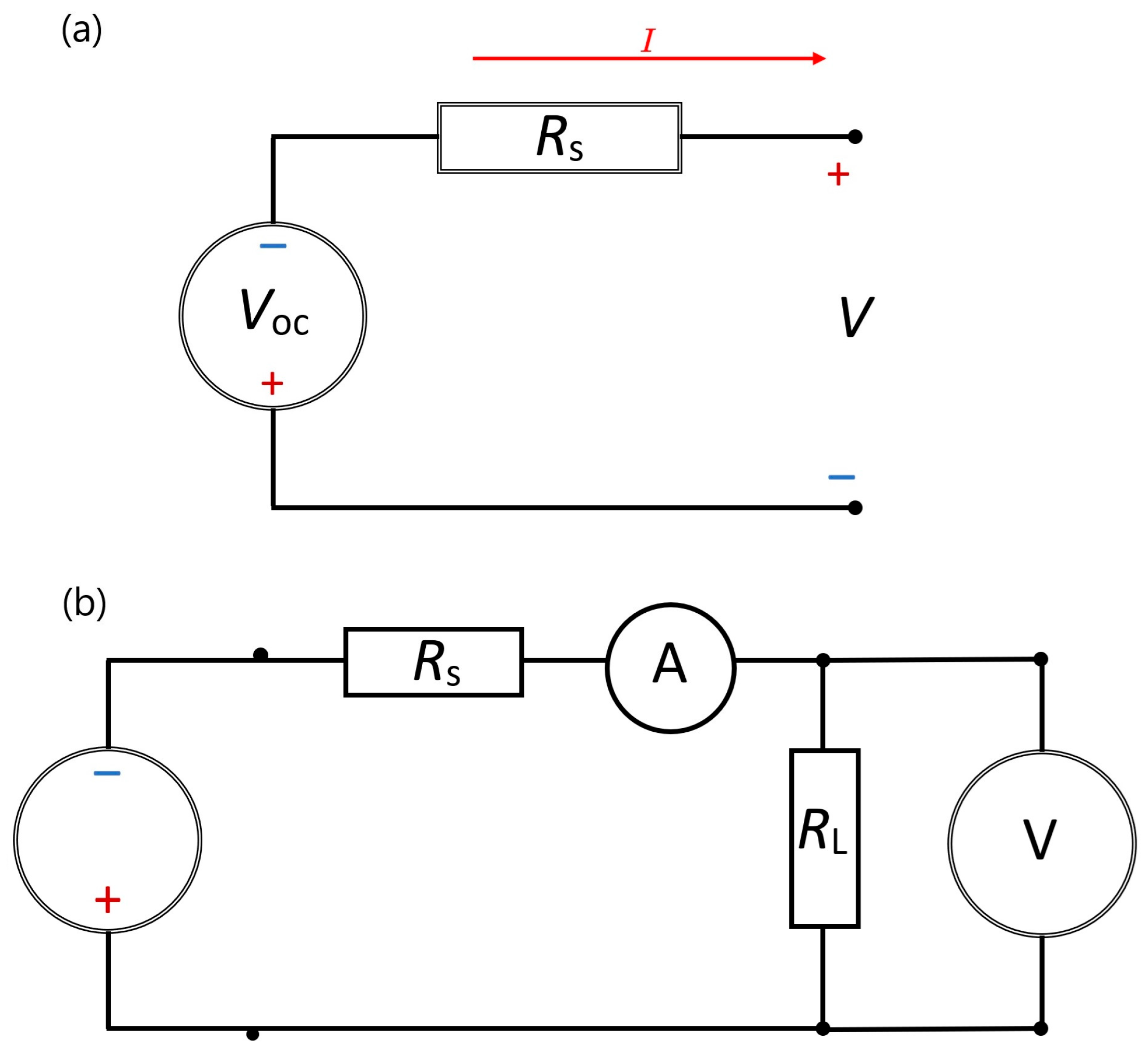
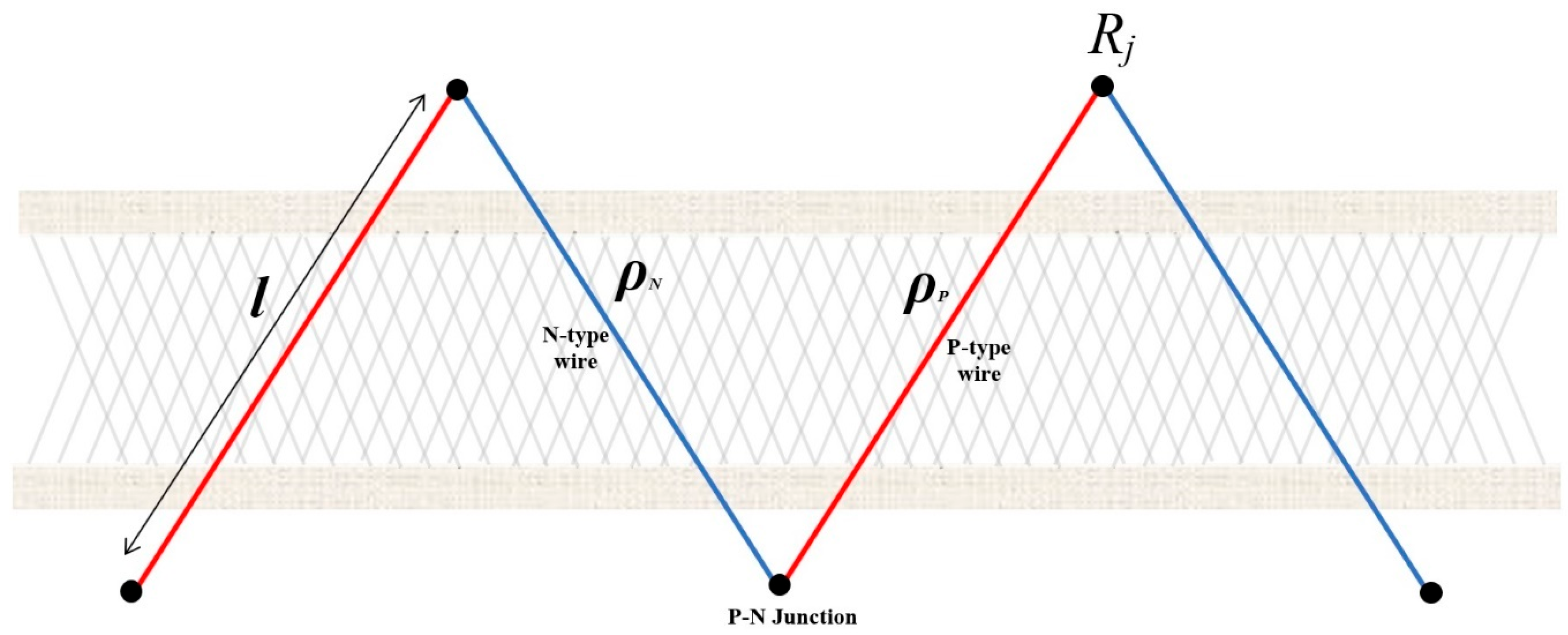
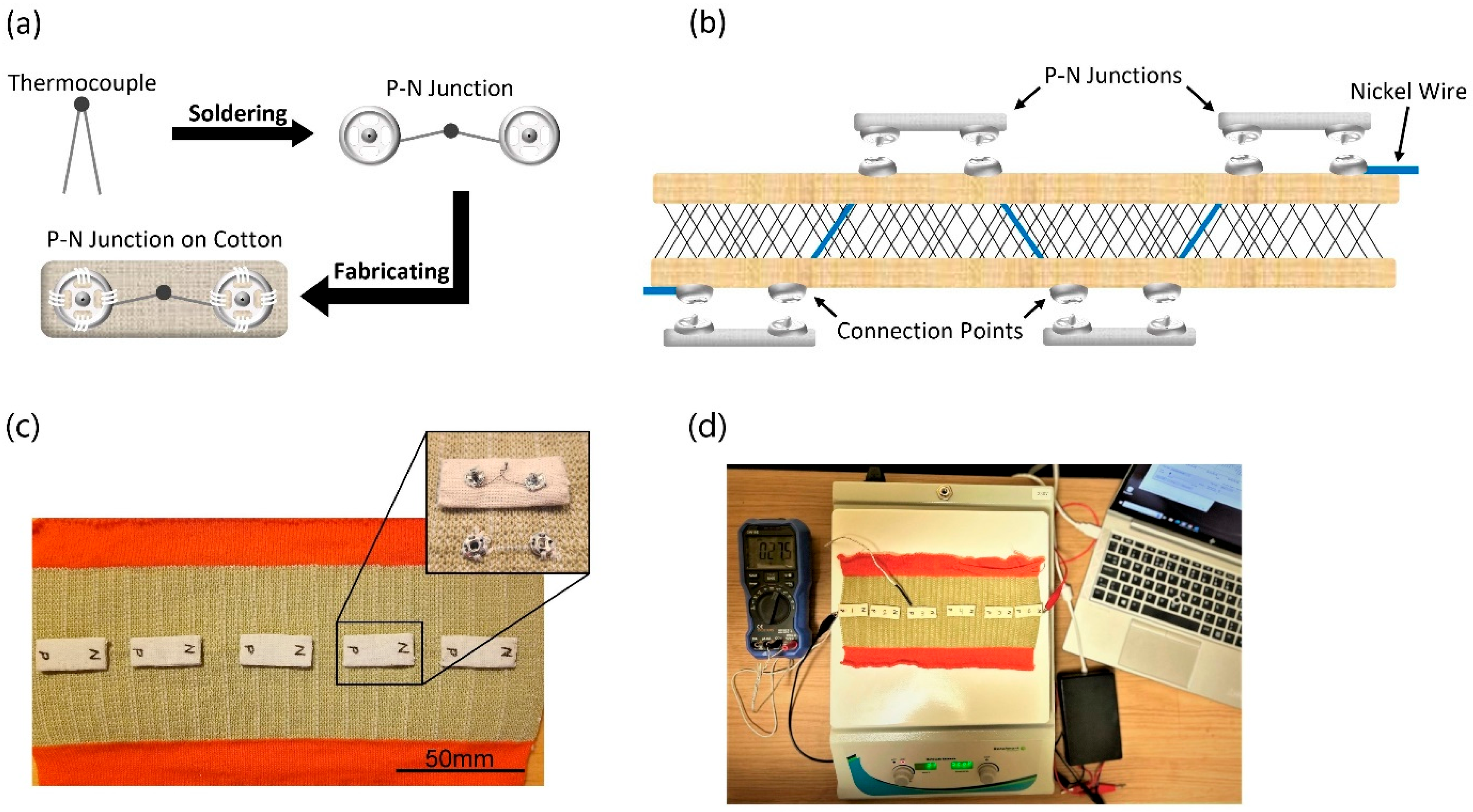
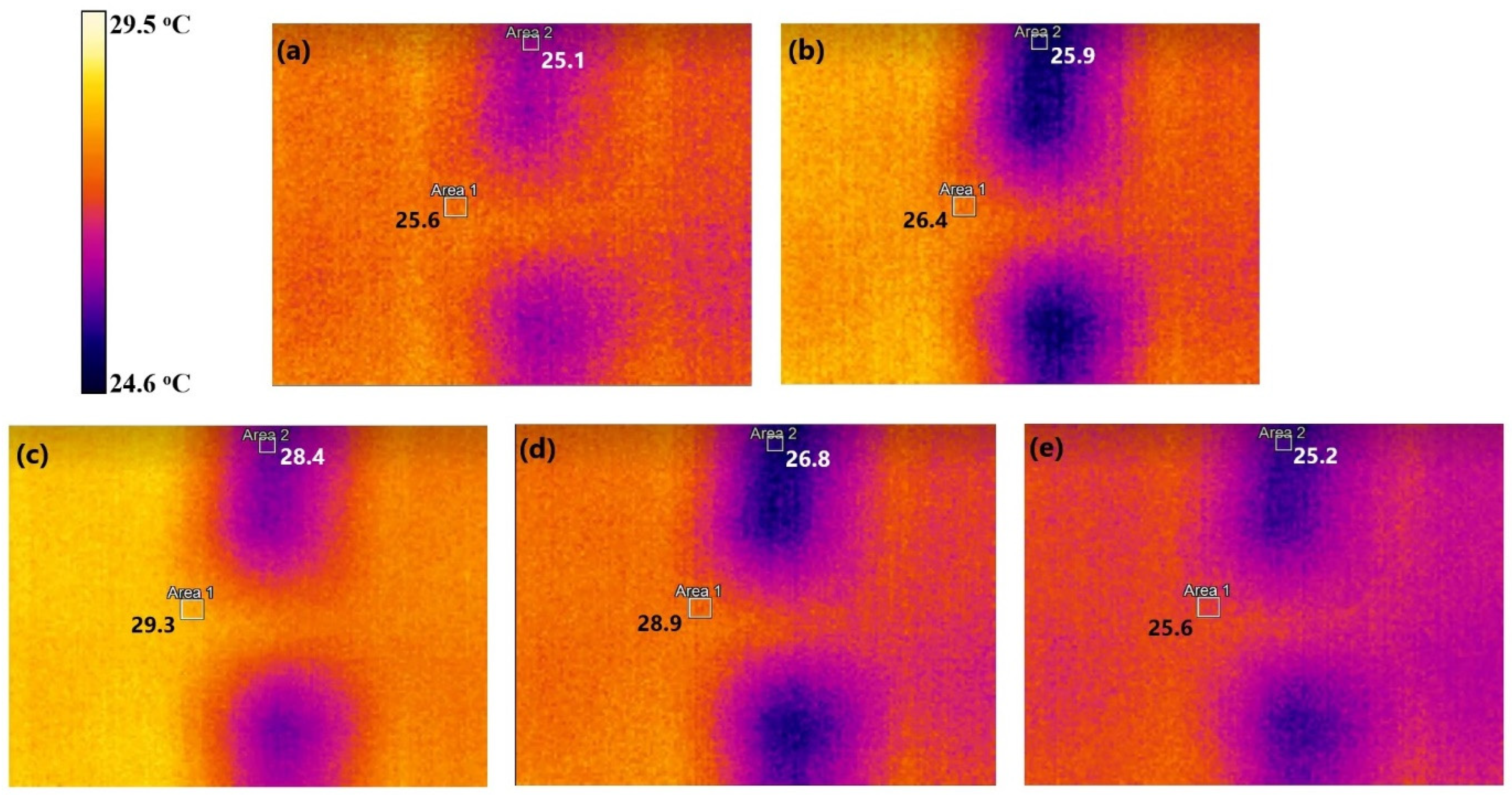

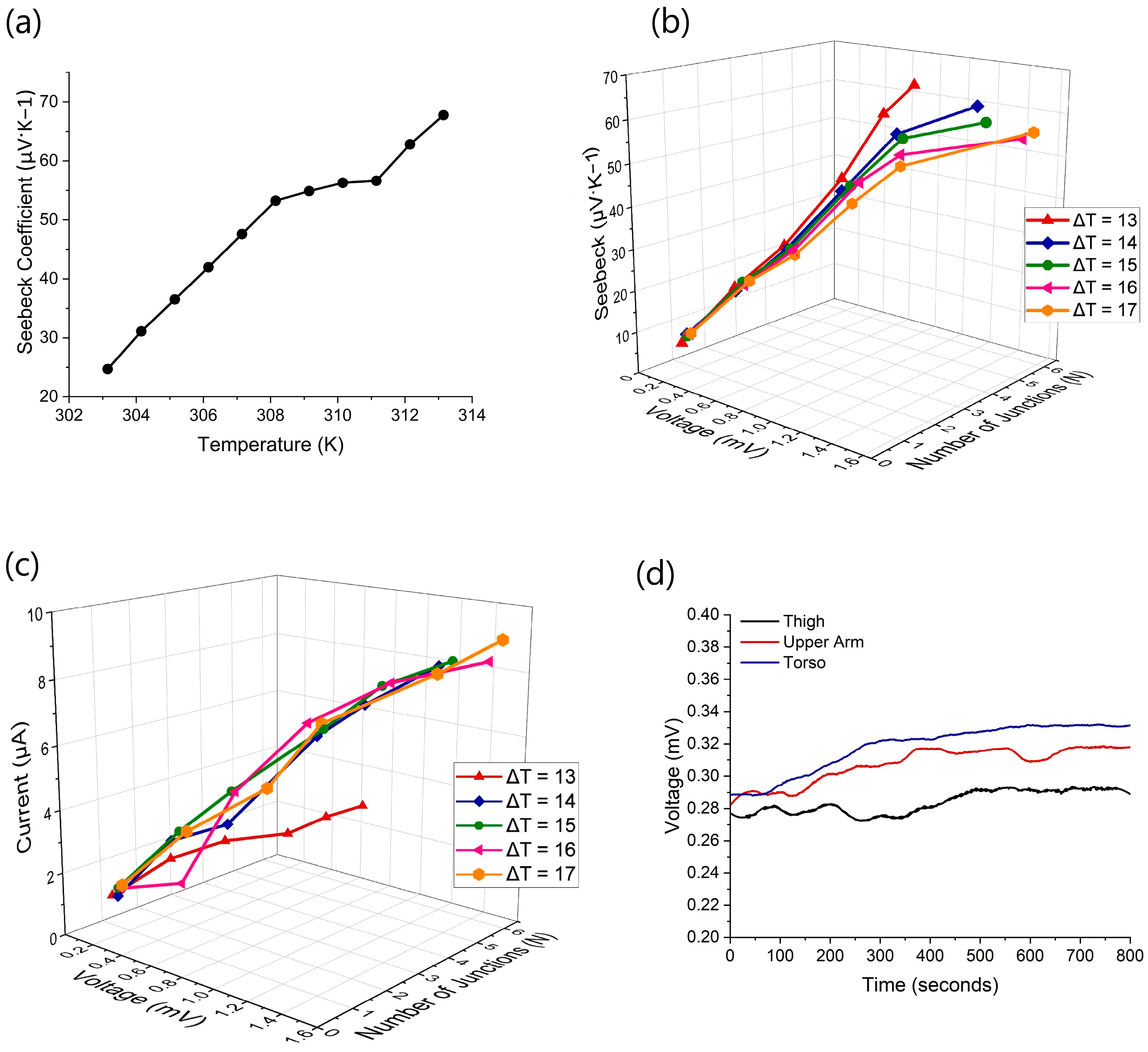
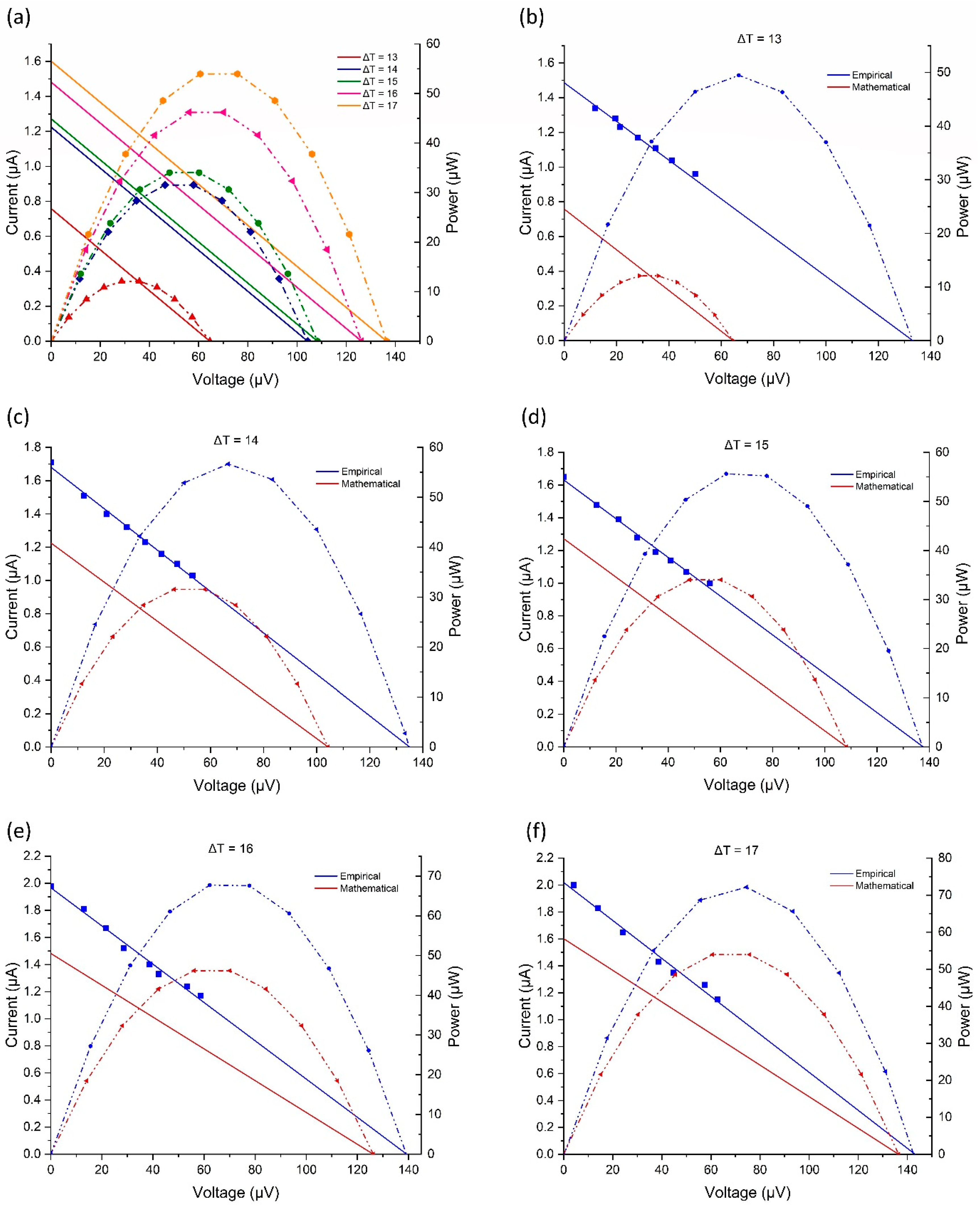
| Device | Material | Junctions | ΔT (K) | Voltage (mV) | Current (µA) | Max Power Point (µW) |
|---|---|---|---|---|---|---|
| Coated Yarn [9] | PEDOT:PSS/MWCNTs/Bi2Te3 | 9 | 20 | 2.19 | 4.7 | 2.64 × 10−3 |
| Conductive strips sewn into Knit Fabric [18] | Ag/Ag2Se strips | 6 | 40 | 13 | 215 | 0.9 |
| Fiber Sewn into Knit Fabric [19] | HrGO/MrGO | 1 | 20 | 0.2 | - | - |
| Wristband with sewn conductive yarn [20] | CNT yarn with Ag NW layer | ~240 | 19 | 20 | 600 | 250 |
| Knitted Yarn Dip-Coated in conductive material [25] | CNT/PVP | 6 | 20 | 0.5 | - | - |
| Flexible Mesh Fabric [26] | Bi2Sb0.3Te2.7/Bi0.5Sb1.5Te3 | 12 | 3.7 | 1.8 | 1.4 × 10−3 | |
| Knitted Structure with Disposable Junctions [This work] | Alumel and Chromel | 11 | 17 | 1.52 | 9.05 | 70 |
Disclaimer/Publisher’s Note: The statements, opinions and data contained in all publications are solely those of the individual author(s) and contributor(s) and not of MDPI and/or the editor(s). MDPI and/or the editor(s) disclaim responsibility for any injury to people or property resulting from any ideas, methods, instructions or products referred to in the content. |
© 2024 by the authors. Licensee MDPI, Basel, Switzerland. This article is an open access article distributed under the terms and conditions of the Creative Commons Attribution (CC BY) license (https://creativecommons.org/licenses/by/4.0/).
Share and Cite
Newby, S.; Mirihanage, W.; Fernando, A. Wearable, Knitted 3D Spacer Thermoelectric Generator with Detachable p-n Junctions for Body Heat Energy Harvesting. Sensors 2024, 24, 5140. https://doi.org/10.3390/s24165140
Newby S, Mirihanage W, Fernando A. Wearable, Knitted 3D Spacer Thermoelectric Generator with Detachable p-n Junctions for Body Heat Energy Harvesting. Sensors. 2024; 24(16):5140. https://doi.org/10.3390/s24165140
Chicago/Turabian StyleNewby, Samantha, Wajira Mirihanage, and Anura Fernando. 2024. "Wearable, Knitted 3D Spacer Thermoelectric Generator with Detachable p-n Junctions for Body Heat Energy Harvesting" Sensors 24, no. 16: 5140. https://doi.org/10.3390/s24165140
APA StyleNewby, S., Mirihanage, W., & Fernando, A. (2024). Wearable, Knitted 3D Spacer Thermoelectric Generator with Detachable p-n Junctions for Body Heat Energy Harvesting. Sensors, 24(16), 5140. https://doi.org/10.3390/s24165140






